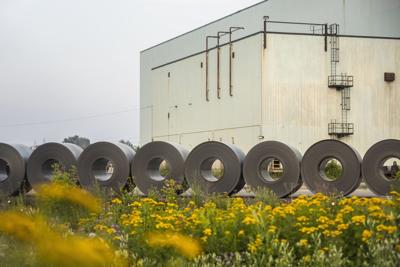The best hope of rescuing the Canadian steel industry might be CanadaÔÇÖs strong interest in nation-building projects.
U.S. President Donald TrumpÔÇÖs 50 per cent tariffs on steel from all sources, not just Canada, has effectively closed the U.S. market to Canadian steelmakers, according to the Canadian Steel Producers Association.
In 2024, Canadian steelmakers exported roughly half their production, and more than 90 per cent of that went to the U.S.
Thousands of jobs are at risk from the Trump tariff regime at CanadaÔÇÖs three major steelmakers: HamiltonÔÇÖs ArcelorMittal Dofasco and Stelco Holdings, and Algoma Steel Group in Sault Ste. Marie.
The three companies are among the worldÔÇÖs oldest steelmakers and are the economic mainstays of their communities.
And together they are the ÔÇťcrown jewelÔÇŁ of Canadian manufacturing, says M├ęlanie Joly, the federal industry minister.
In the current negotiations between Canada and the Trump administration on a new trade regime, Ottawa is trying to soften the blow of U.S. tariffs on too many Canadian economic sectors to achieve success everywhere.
Trump has targeted Canadian automaking, steel, forest products, aluminum, dairy products and other sectors with tariffs.
The Canadian steel and auto sectors are among the most vulnerable to U.S. protectionism. The U.S. doesnÔÇÖt rely on their output the way it does on Canadian energy exports, for instance.
Ottawa has taken steps to protect Canadian steelmaking. It will provide income supports to steelworkers coping with tariff-related job loss.
The Carney government has cracked down on dumping, in which foreign producers sell their excess steel at below-cost prices in the Canadian market, undercutting domestic producers.
Ottawa has also created a $10-billion emergency relief fund for large companies affected by the U.S. tariffs. Algoma has applied to the fund for $500 million in liquidity as its U.S. demand has fallen.
On Tuesday, Algoma reported that it lost $110.6 million in its latest quarter, compared with a $6.1-million profit in the same period last year.
Algoma, which employs about 2,600 people, is the sole Canadian-owned major steelmaker.
Stelco was acquired last year by a U.S. steelmaker, Cleveland-Cliffs of Ohio. ArcelorMittal Dofasco, which employs almost 10,000 people, is controlled by Indian steel magnate Lakshmi Mittal.
Apart from the anti-dumping measures, OttawaÔÇÖs efforts to ensure the survival of Canadian steelmaking donÔÇÖt address the industryÔÇÖs crisis in reduced demand.
But as it happens, Canada imports about two-thirds of the steel it uses rather than prioritizing domestic steel.
ÔÇťWe have the potential to become our own best customer for steel,ÔÇŁ Prime Minister Mark Carney said earlier this month.
ÔÇťWe must rely more on Canadian steel for Canadian projects,ÔÇŁ Carney said.
ArcelorMittal Dofasco, like its two peers in Canada, is turning inward, looking for more Canadian business to cover the shortfall of U.S. orders.
ÔÇťIf we continue to focus on Canada ÔÇŽ building out our bridges, building out infrastructure and providing housing, we can participate in those things, whether or not thereÔÇÖs a 50 per cent tariff,ÔÇŁ Ron Bedard, CEO of ArcelorMittal Dofasco, said at the Canadian Automotive Summit in Vaughan, Ont., last month.
Ottawa canÔÇÖt force Canadian steel consumers to switch to domestic steel from imports, often from the U.S.
But itÔÇÖs another story with projects built or financed by Canadian governments.
Canada is in great need of rebuilding.
And in a way itÔÇÖs fortunate that Canadian steelmaking capacity has been freed up to make nation-building projects possible without driving up steel prices, as would happen in normal times.
Joly wants Canadian steel used in expanding CanadaÔÇÖs aerospace sector and building submarines and other military goods.
Large quantities of Canadian steel will also be required in new infrastructure projects.
They include modernizing the congested Port of Vancouver, which handles half of CanadaÔÇÖs port traffic and is the gateway to Asia-Pacific markets in which Canada seeks a greater presence. The tangle of rail lines that feed the port are a bottleneck that also needs rebuilding.
Canadian steel will be needed for proposed pipelines traversing Western and Central Canada.
It will be needed for wind farms and solar installations as Canada expands its renewable energy production.
P.E.I. would like a second fixed link to the mainland to match the Confederation Bridge. BC Ferries needs to upgrade its aging fleet, one of the worldÔÇÖs largest.
Canadian steel will be required for new armed forces bases in the Far North to better secure Canadian sovereignty in the Arctic.
It will be needed to largely replace an out-of-date long-term-care sector where a disproportionate number of pandemic victims died.
And to build hospitals, housing, recreation centres and all-season roads in CanadaÔÇÖs Indigenous communities.┬á
That remedy will have only a modest impact in the short term since projects can take years to plan. All the more reason to speed up that process.
The reward is a more productive and globally competitive Canadian economy. One that is more thoroughly modernized, in everything from freight transportation to eldercare, even than the U.S.



























To join the conversation set a first and last name in your user profile.
Sign in or register for free to join the Conversation